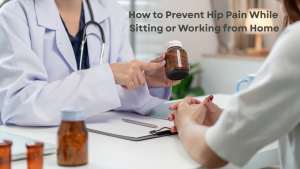Introduction
Osteonecrosis, sometimes known as avascular necrosis (AVN), is a serious condition that occurs when the blood supply to a bone is interrupted, leading to the death of the bone tissue. This can occur in any bone in the body, but it is particularly problematic when it affects the hip joint. In the hip, osteonecrosis can lead to the collapse of the femoral head (the ball part of the hip joint), which causes immense pain and can severely limit a person’s ability to move.
As we move into 2025, the treatments available for hip osteonecrosis have improved significantly. With advances in medicine, research, and technology, we now have more effective means of managing this condition, alleviating its symptoms, and possibly even avoiding surgery altogether. This article will present both available non-surgical and surgical treatment options and discuss their respective efficacies.
1. What Causes Hip Osteonecrosis?
Understanding what causes hip osteonecrosis is crucial in determining how to treat it. The condition typically arises when the blood flow to the femoral head is disrupted, causing the bone tissue to die. When the bone doesn’t receive enough blood, it becomes weaker and can eventually collapse, leading to joint instability and severe pain.
Here are the most common causes of hip osteonecrosis:
Chronic Use of Corticosteroids: Extended use of corticosteroids (like prednisone) plays a big role in causing osteonecrosis. Doctors often prescribe these drugs to treat swelling in conditions such as arthritis. However, they can mess with the body’s ability to fix bones. They cut down the blood supply to bones making them weaker as time goes on. When someone takes corticosteroids for a long time, it’s crucial to keep a close eye on their bone health. This helps prevent osteonecrosis from developing.
Excessive Alcohol Consumption:
Drinking excessive alcohol regularly leads to fat buildup in blood vessels and block blood flow, starving bones like the femoral head of oxygen and nutrients they need for health, which increases their risk for osteonecrosis in time. Heavy drinkers are at high risk, particularly when combined with risk factors like steroid use.
Medical Conditions:
A few conditions, like sickle cell anemia, lupus, and HIV, can make individuals more susceptible to osteonecrosis. These conditions affect blood flow in different ways, which can impact the bones, particularly the femoral head. People with these conditions are often at higher risk for osteonecrosis, and special attention should be given to their bone health.
Genetics: Osteonecrosis may also be caused by hereditary factors. Few can get it through their genes even without experiencing trauma, taking steroids, or other contributing factors. If there is a family history of osteonecrosis, it’s essential that it’s discussed with healthcare providers as early as possible. It helps in understanding each aspect.
2. Symptoms of Hip Osteonecrosis
The symptoms of hip osteonecrosis vary depending on the stage of the disease, but there are common signs that indicate the condition is developing. People may not initially notice significant symptoms, especially in the early stages, but as the disease progresses, the pain and disability become more pronounced.
The most common symptoms include:
Hip Pain: Early on, the pain associated with hip osteonecrosis might be mild and intermittent. The pain may come and go, and at first, it may only occur during physical activity, such as walking or climbing stairs. Although, as this condition progresses, the pain becomes constant and more intense. It may begin to radiate to other areas such as the groin, thigh, or buttocks.
Limit of Motion: As this condition progresses, the hip joint becomes stiffer, making movement increasingly challenging in specific directions. People may struggle to rotate or bend their hip fully or extend fully; as a result, daily activities like walking, sitting down, and getting in and out of cars may become increasingly limited as stiffness diminishes movement abilities.
Limping: Due to pain and stiffness, many individuals with hip osteonecrosis develop a limp. The limp can develop gradually as people unconsciously alter their gait to avoid putting weight on the affected hip. Over time, this can lead to further issues, including back and knee pain, as the body compensates for the hip joint’s dysfunction.
Weakness or Instability: Osteonecrosis causes the femoral head to collapse, making the hip joint unsteady and making weight bearing on affected limbs difficult and increasing the risk of falls. People may feel weak or unstable while standing, walking, or moving, potentially increasing risks when moving around or walking alone.
The severity of symptoms varies from person to person, depending on how far the condition has progressed, while early detection is crucial to managing symptoms and preventing further damage to the hip joint.
The Four Stages of Osteonecrosis
Understanding the progression of osteonecrosis is essential for determining the best course of treatment. The condition is typically divided into four stages, based on the severity of bone damage and joint dysfunction:
Stage I: Early Stage (No Visible Changes on X-rays)
In this initial stage, there are no visible signs of osteonecrosis on an X-ray. The bone may still appear normal, but the individual may experience mild discomfort or pain in the hip or groin, especially during physical activity. Diagnosing osteonecrosis at this stage can be difficult because the X-rays won’t show any significant changes. However, MRI or bone scans can sometimes detect early signs of the disease, allowing for earlier intervention and potentially slowing the progression of the condition.
Stage II: Moderate Stage (Bone Changes Visible on X-rays)
By this stage, X-rays may show visible changes in the bone, such as small areas of damage or weakening. Pain often intensifies during activity and may become more constant. Though the bone may show signs of weakening, the joint’s overall structure remains relatively same. At this point, treatment options like medicines and physical therapy still be effective in managing symptoms and preventing further deterioration.
Stage III (Advanced Stage: Bone Collapse Begins)
In Stage III, bone collapse begins and results in significant joint dysfunction and an increase in pain intensity as the femoral head collapses, with symptoms including difficulty walking and standing. People may even have difficulty sitting up properly in bed. The cartilage that covers the femoral head may begin to wear away, further restricting the joint’s range of motion. At this stage, the disease is more challenging to treat conservatively, and surgical options may become necessary.
Stage IV: Final Stage (Complete Joint Collapse)
Stage IV is the most severe stage of osteonecrosis. At this point, the hip joint has fully collapsed, and there is extensive damage to both the bone and cartilage. Pain is often constant and debilitating, and joint function is severely impaired. Mobility becomes extremely limited, and hip replacement surgery is often required to restore function and relieve pain.
Each of these stages requires a different approach to treatment, and early-stage intervention is crucial for preventing the need for more invasive procedures like hip replacement.
3. How Does Hip Osteonecrosis Affect Diagnosis?
Hip osteonecrosis diagnosis starts with a comprehensive physical exam conducted by your physician to assess the range of motion in your hip joint, look for signs of pain or discomfort, and discuss any past medical histories you have had.
If osteonecrosis is suspected, various diagnostic tools will be utilized in order to confirm it as well as assess bone damage:
X-Rays: X-rays are often the first imaging test used to assess hip joint health, showing any visible changes that require further investigation, such as areas of damage or bone collapse. Unfortunately, however, early-stage osteonecrosis might go undetected by X-rays as its symptoms take time to become evident.
MRI Scans: Magnetic Resonance Imaging (MRI) It is the most used method for detecting osteonecrosis, especially in the early stages when bone changes may not yet be visible on X-rays. MRI scans provide detailed images of both the bones and soft tissues, helping doctors assess the extent of bone damage and the health of the hip joint.
CT Scans: Computed Tomography (CT) scans gives detailed cross sectional images of the bones and these helps doctors to evaluate the severity of bone damage and determine the best treatment options.
Bone Scintigraphy (Bone Scan): A bone scan detects abnormalities in bone metabolism, which can be an early indicator of osteonecrosis. This test may be used when other imaging techniques don’t provide clear results.
Early diagnosis is essential because it allows us to begin treatment before the condition progresses too far. The sooner we catch osteonecrosis, the more options we have for managing the disease and preventing the need for surgery.
4. Non-Surgical Treatments for Hip Osteonecrosis
Non-surgical treatments play an essential role in managing hip osteonecrosis, particularly in the earlier stages of the disease.
These treatments aim to alleviate pain, slow the progression of the disease, and maintain or improve the functionality of the hip joint without the need for surgery.
Let’s explore each non-surgical treatment in more detail:
Medications: Medications are often the first line of defense in managing pain and inflammation associated with osteonecrosis. Depending on the severity of the symptoms, different types of medications are recommended.
Pain Relief: Over-the-counter medications like ibuprofen (Advil) or acetaminophen (Tylenol) is commonly used to manage mild to moderate pain associated with hip osteonecrosis. It helps to reduce pain and inflammation and are effective for many people, especially during the earlier stages of the disease. However, for more intense pain, prescription medications, such as stronger pain relievers or opioids, may be prescribed for short-term use.
Anti-inflammatory Drugs (NSAIDs): Nonsteroidal anti-inflammatory drugs (NSAIDs), like naproxen (Aleve) or aspirin, are frequently prescribed to alleviate inflammation in hip joints and relieve associated pain and swelling, work by blocking enzymes that responsible for inflammation to improve joint function while providing pain relief; however, long-term use may result in side effects, including gastrointestinal issues; therefore, it should only be undertaken under medical advice.
Bisphosphonates: Bisphosphonates are medications primarily used to treat osteoporosis, a condition that causes bones to become weak and brittle. In osteonecrosis, bisphosphonates may help slow the progression of bone loss and preserve bone density. However, their effectiveness in treating hip osteonecrosis is still under study, and they are typically used in conjunction with other treatments.
Physical Therapy: Physical therapy (PT) is a crucial part of managing hip osteonecrosis. Physical therapists design exercise programs tailored to an individual’s needs, focusing on improving joint mobility, strength, and flexibility. For people with hip osteonecrosis, PT offers several benefits.
Pain Relief: Specific exercises can help relieve pain and reduce muscle tension in the hip joint. Stretching and strengthening exercises reduce stiffness and improve the overall function of the joint.
Improved Flexibility: As osteonecrosis progresses, the hip joint may stiffen up and make movement more difficult. Physical therapy can help increase range of motion by engaging in exercises designed to stretch out muscles and tissues around the hip joint – this may prevent further loss of mobility and maintain functional independence for longer.
Strengthening the Muscles Around the Hip: Strengthening exercises improve the muscles around the hip joint, which helps to stabilize the joint. Strong muscles can reduce the strain on the bones and cartilage, easing pain and improving mobility. In addition, strong muscles protect the joint from further wear and tear.

Posture and Gait Training: Many people with hip osteonecrosis develop abnormal gait patterns or a limp to compensate for pain. Physical therapy helps retrain the body to walk properly and may reduce the risk of developing secondary conditions, such as back or knee pain.
Lifestyle Modifications: Certain lifestyle changes can significantly improve the quality of life for individuals with hip osteonecrosis. These modifications focus on reducing joint stress, preventing further damage, and helping individuals stay active.
Activity Modification: People with osteonecrosis should avoid high-impact activities that place additional stress on the hip joint, such as running or jumping. These activities can worsen pain and accelerate joint damage. Instead, low-impact exercises like swimming, cycling, or using an elliptical machine are recommended. These activities provide cardiovascular benefits while minimizing stress on the joints.
Assistive Devices: The use of assistive devices, such as canes or walkers, can help reduce the weight-bearing load on the affected hip, making movement less painful. These devices help improve stability, decrease the risk of falling, and improve mobility in people who have difficulty walking due to osteonecrosis.
Weight Management: Maintaining a healthy weight can be one of the best ways to ease strain on the hip joint. Excess body weight places undue strain on hips, aggravating discomfort and hastening osteonecrosis progression.
By following a diet and exercising to control their weight, individuals can ease pressure on joints and alleviate joint pain. Weight control is especially essential for individuals who are overweight or obese as carrying extra weight will place additional strain on hip joints over time.
5. Surgical Treatments for Hip Osteonecrosis
In cases where non-surgical treatments do not provide sufficient relief, surgery may be necessary to restore joint function and alleviate pain. Surgical options vary depending on the severity of the osteonecrosis and the stage of the disease. Here are the most common surgical treatments for hip osteonecrosis:
Core Decompression: Core decompression is a minimally invasive procedure typically used in the early stages of osteonecrosis. In this procedure, the surgeon removes a portion of the femoral bone to relieve pressure and improve blood flow to the affected area. The goal is to promote the healing of the bone and prevent further bone death.
How It Works: A small hole is drilled into the femoral head, and some of the bone is removed. This procedure helps to reduce the pressure within the bone, allowing for better circulation and improved blood flow to the bone tissue. This can slow the progression of the disease and delay the need for a hip replacement.
Benefits: Core decompression is a less invasive option than hip replacement surgery and has a shorter recovery time. It can help delay or avoid the need for more extensive surgery in some cases.
Limitations: This procedure is most effective in the early stages of osteonecrosis. Once the bone has collapsed, core decompression may no longer be sufficient to restore joint function.
Osteotomy: Osteotomy is a surgical procedure in which the surgeon cuts and reshapes the bone to change the way weight is distributed across the joint. In the case of hip osteonecrosis, osteotomy can help redistribute the load on the femoral head, reducing pressure on the damaged area and slowing the progression of the disease.
How It Works: The surgeon makes cuts in the bone to realign the femoral head, which can help preserve the hip joint for a longer period of time. The goal is to relieve pressure on the damaged bone and cartilage.
Benefits: Osteotomy can help delay or avoid the need for hip replacement, particularly in younger patients who still have a significant amount of healthy bone and cartilage. It can provide pain relief and improve joint function.
Limitations: Osteotomy is typically reserved for individuals with less severe osteonecrosis, especially younger patients who are still in the early to moderate stages of the disease. It may not be effective in advanced cases where the femoral head has already collapsed.
Bone Grafting: Bone Grafting Bone grafting involves implanting healthy bone tissue into an affected area to aid healing and strengthen the femoral head. This procedure may be combined with core decompression for enhanced effectiveness.
How It Works: Healthy bone tissue taken from another part of a patient’s body or from donors is used to fill damaged areas in the femoral head and stimulate bone regrowth while strengthening it overall. This method results in enhanced bone strength and increased ability to move freely over time.
Hip Replacement Surger: For individuals with advanced osteonecrosis, hip replacement surgery is often the most effective solution. During this procedure, the damaged femoral head and acetabulum (the hip socket) are replaced with artificial components, restoring joint function and relieving pain.
How It Works: In a total hip replacement (THR), the surgeon removes the damaged bone and cartilage and replaces them with prosthetic components made of metal, plastic, or ceramic. This new joint allows for improved mobility and significant pain relief.
Limitations: Hip replacement surgery is typically reserved for individuals with advanced osteonecrosis when other treatments have failed. It requires a longer recovery period and carries risks, such as infection, blood clots, and implant failure.
6. Emerging Treatments for Hip Osteonecrosis
In recent years, several new treatments have been developed that offer hope for individuals with hip osteonecrosis, particularly those who are not candidates for traditional surgery. These emerging therapies focus on promoting tissue repair, reducing inflammation, and improving bone health.
Platelet-Rich Plasma (PRP) Injections
PRP therapy involves injecting a concentrated solution of the patient’s own platelets into the affected area. The platelets contain growth factors that promote tissue healing and reduce inflammation.
How It Works: PRP injections are derived from the patient’s own blood, which is processed to concentrate the platelets. The resulting solution is injected into the damaged area of the hip joint to stimulate healing and reduce pain.
Benefits: PRP therapy has been shown to reduce inflammation and promote tissue repair, potentially slowing the progression of osteonecrosis and improving joint function.
Limitations: While promising, PRP therapy is still being studied, and its long-term effectiveness for hip osteonecrosis is not yet fully established.
SVF Therapy (Stromal Vascular Fraction Therapy)
SVF therapy is an advanced regenerative treatment that uses stem cells to promote tissue repair. Derived from the patient’s own fat tissue, SVF contains stem cells, regenerative cells, and growth factors that can help repair damaged bone and tissue.
How It Works: Fat tissue is collected from the patient, and the SVF is extracted. This mixture is then injected into the affected hip joint to stimulate healing and promote bone regeneration.
Benefits: SVF therapy holds significant promise in regenerating damaged bone tissue and slowing the progression of osteonecrosis. It may be particularly useful for patients who are not candidates for traditional surgery.
Limitations: SVF therapy is still an experimental treatment, and its effectiveness in treating osteonecrosis is still being evaluated. It may not be suitable for all patients.
Hyaluronic Acid Injections
Hyaluronic acid injections help lubricate the hip joint, providing relief from pain and inflammation.
How It Works: Hyaluronic acid is a natural substance found in the joints that helps lubricate and cushion the cartilage. By injecting hyaluronic acid into the hip joint, we can reduce friction, improve mobility, and relieve pain.
Benefits: Hyaluronic acid injections provide temporary pain relief and may improve mobility by enhancing joint lubrication.
7. Preventing Hip Osteonecrosis
While some risk factors for osteonecrosis, like genetics, are uncontrollable, there are several strategies to reduce the risk of developing the disease or slowing its progression:
Avoid Excessive Alcohol Use: Limiting alcohol intake can help prevent fat buildup in the blood vessels, reducing the risk of osteonecrosis. Reducing alcohol consumption can benefit overall bone health.
Monitor Corticosteroid Use: If you need long-term corticosteroid therapy, we recommend periodic monitoring to assess bone health. Your doctor may adjust your medication or suggest alternatives to reduce the impact on your bones.
Maintain a Healthy Weight: Keeping your weight in a healthy range reduces strain on the hip joint and can help prevent further damage. Weight management also reduces the risk of developing other conditions that may contribute to osteonecrosis.
Exercise Regularly: Engaging in weight-bearing exercises like walking, jogging, or weight training helps maintain bone density and strength, potentially preventing osteonecrosis or slowing its progression.
Takeaway: Hip osteonecrosis is a progressive condition that impacts one’s quality of life. However, advances in both non-surgical and surgical treatments have improved the ability to manage the condition effectively.
FAQs
What are the early signs of hip osteonecrosis?
Early signs include mild hip or groin pain that worsens with activity. Limited range of motion and stiffness may also develop.
How long can you live with hip osteonecrosis?
With early intervention, non-surgical treatments can help manage the condition for years. If left untreated, hip replacement surgery may be required.
Can lifestyle changes help manage hip osteonecrosis?
Yes, lifestyle modifications like controlling weight, avoiding high-impact activities, and physical therapy can significantly alleviate symptoms.
Is hip replacement surgery always necessary for osteonecrosis?
Hip replacement is typically needed in advanced cases, but many patients can benefit from non-surgical options in the earlier stages.
Are there new treatments for hip osteonecrosis in 2025?
Yes, emerging treatments such as SVF, PRP injections, and hyaluronic acid injections show promise for managing hip osteonecrosis in 2025.






